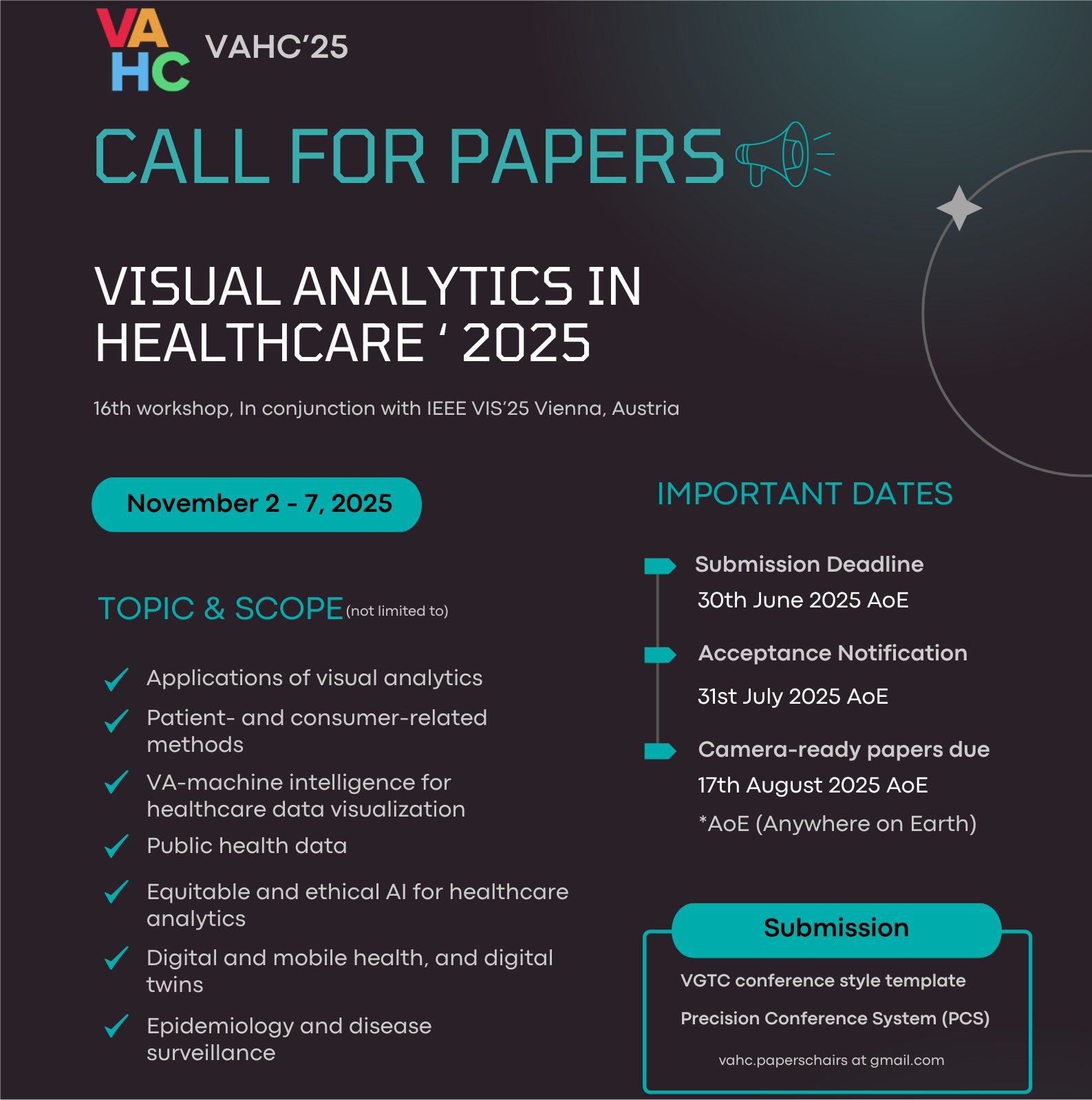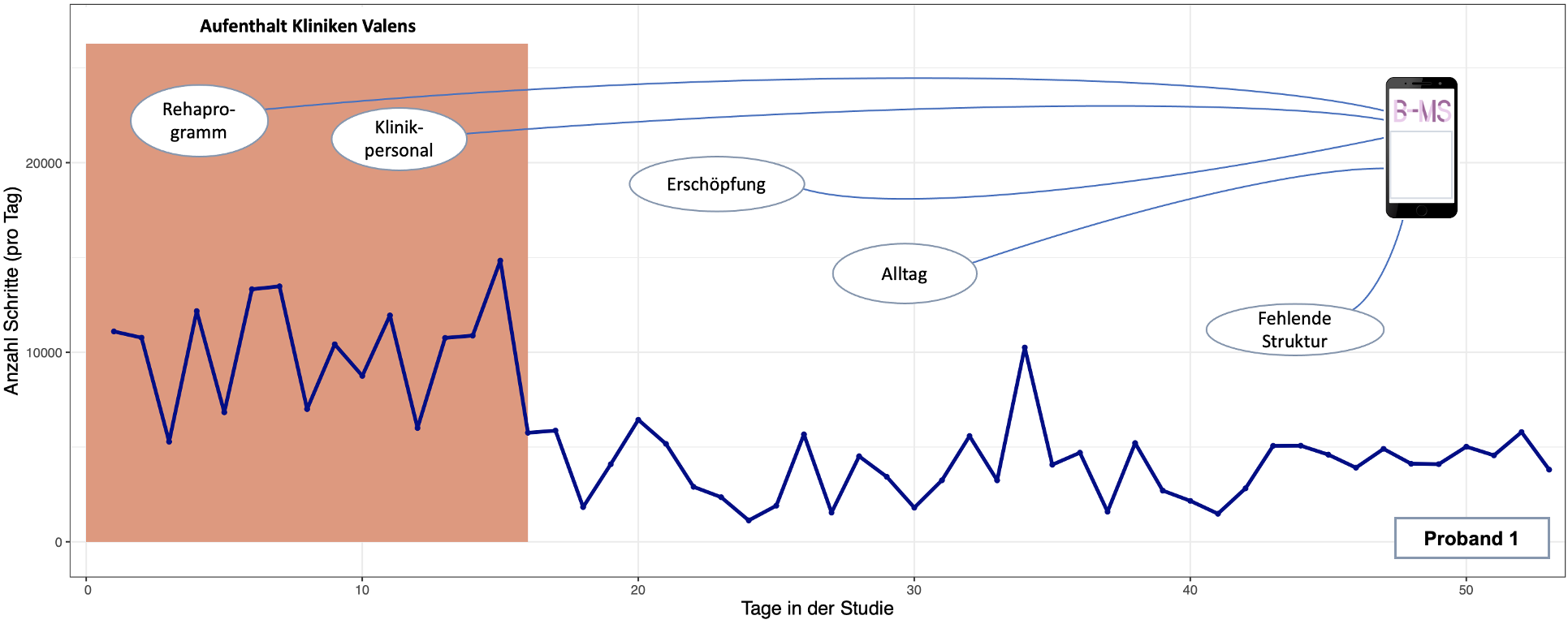Visual Analytics in Healthcare (VAHC)

Introduction

The analysis of medical data is relevant for many use cases, including clinical research and patient treatment. While these cases typically represent a doctors'/physicians' perspective, there is yet another user group with an immense information need: patients. In addition, other types of stakeholders involved in the medical domain are, e.g., clinics, quality management environments, operational staff, and insurances.
Healthcare is a premier application domain of the IVDA group. A series of publications was published in collaboration with experts in the medical and patient-centered domain. The overarching approach of IVDA is to conduct design study, i.e., research projects in which we
-
analyze a specific real-world problem faced by domain experts
-
design a visualization system that supports solving this problem, validate the design, and
-
reflect about lessons learned in order to refine visualization design guidelines
Publications
The IVDA group members have been involved in a series of publications regarding visual analytics in healthcare. An overview of publications on Visual Analytics in Health Care can be found here.
Workshop: Visual Analytics in Healthcare (VAHC)
The Workshop on Visual Analytics in Healthcare (VAHC) is the premier research event exploring the application of data visualization and visual analytics to biomedicine. VAHC brings together medical experts, leading scientists, and visionaries to discuss opportunities and challenges in using visual analytics techniques to help patients, clinicians, public health researchers, and others leverage the power of complex health datasets.
📢 We are organizing VAHC at IEEE VIS 2025 in Vienna!
🔬 From the IVDA Group of the University of Zurich:
– Gabriela Morgenshtern is part of the organizing committee
– Dr. Jana Sedlakova serves as Paper Chair
– Prof. Jürgen Bernard is in the Steering Committee and Grand Challenges Chair
🤝 We are co-organizing VAHC together with our colleagues and friends in their committee roles, bringing together a strong team from visual analytics and healthcare.
General Chair
- Alessio Arleo, TU Eindhoven
Organizers
- Renata Raidou, TU Wien
- Gabriela Morgenstern, University of Zurich
Steering Committee
-Jürgen Bernard, University of Zurich
- Annie T. Chen, University of Washington
- David Gotz, UNC-Chapel Hill
- Danny T.Y. Wu, UNC-Chapel Hill
Grand Challenge Chairs
- Jürgen Bernard, University of Zurich
- Silvia Miksch, TU Wien
- David Gotz, UNC-Chapel Hill
Paper Chairs
-Velitchko Filipov, TU Wien
- Robert Laramee, University of Nottingham
- Roy Ruddle, University of Leeds
- Jana Sedlakova, University of Zurich
Publicity Chairs
- Sandhya Rajendran, TU Wien
- Markus Höhn, Fraunhofer IGD
Join us to shape the discussion on visual analytics for real-world healthcare challenges.
Details on the VAHC Website
VAHC Workshop 2025 at IEEE VIS, Vienna: Call for Papers!

📄 The Call for Papers is now out!
We invite submissions to the 16th Visual Analytics in Healthcare (VAHC) Workshop, held in conjunction with IEEE VIS 2025 in Vienna, Austria (November 2–7, 2025). VAHC brings together researchers and practitioners to advance visual methods for analyzing healthcare data. Topics include (but are not limited to): applications of visual analytics, public and mobile health, patient-centered methods, ethical AI, and epidemiological surveillance.
🗓 Submission deadline: June 30th, AoE
Details on the VAHC Website
Visual Analytics for Prostate Cancer Research
One of the focused diseases of the past is prostate cancer which is the most frequently occurring type of cancer for men. IVDA systems to support clinicians and researchers in their data-centered analyses include
- Visualizing longitudinal patient histories
- Visualizing longitudinal histories of patient cohorts
- Comparing multiple parameters of multiple patient cohorts at the same time
- Exploring time-oriented health parameters
- Exploring unknown relations between time-oriented static health parameters
Visual Analytics for Multiple Sclerosis Research

Mockup data as recorded in a study on Multiple Sclerosis for a single patient. The step count of a patient is recorded for every day, here visualized as a linechart. In addition, a variety of other types of (sensor) data is recorded over time, e.g., by using wearables:
- Acceleration data
- Motion-behavior data
- Everyday life and well-being data
- Weather data
Background
Chronic diseases such as Multiple Sclerosis (MS) create a huge burden for patients and their relatives. With the availability of wearables and other types of (sensor) data, it is now possible to apply data-driven approaches to contribute to patient health. Of particular interest is the identification of biomarkers for the reliable detection of relevant health changes of MS patients. The identification of biomarkers can be performed with two complementary approaches: exploratory data analysis (the data scientists' preferred approach) and confirmatory data analysis (the epidemiologists' preferred approach). Different types of techniques borrowed from Machine Learning, Data Mining, and Information Retrieval may be applied and combined to provide effective and efficient solutions for the analysis of medical and patient-related data.
Challenges
Despite its benefit, the analysis of medical data comes with a series of challenges. First, data from different sources need to be combined to a unified data collection. Second, data collections such as electronic health records often have quality problems and require manual (pre-) processing. Third, algorithmic models applied to medical data need to be selected, parameterized, trained, and validated. In most cases, this process is iterative and urgently requires humans in the loop. Fourth, the analysis of model outputs is often not trivial and decisions of models are not always explainable. Finally, involved user groups such as physicians, patients, but also operational staff have very different levels of expertise and interest, which requires a careful characterization of the domain problem and analysis tasks to ensure that the tool to be built is both usable and useful.
Approach
IVDA has proven to be a promising approach to medical data analysis. The particular benefit of IVDA tools is the ability to combine the strengths of both humans and machines in a unified data analysis workflow.